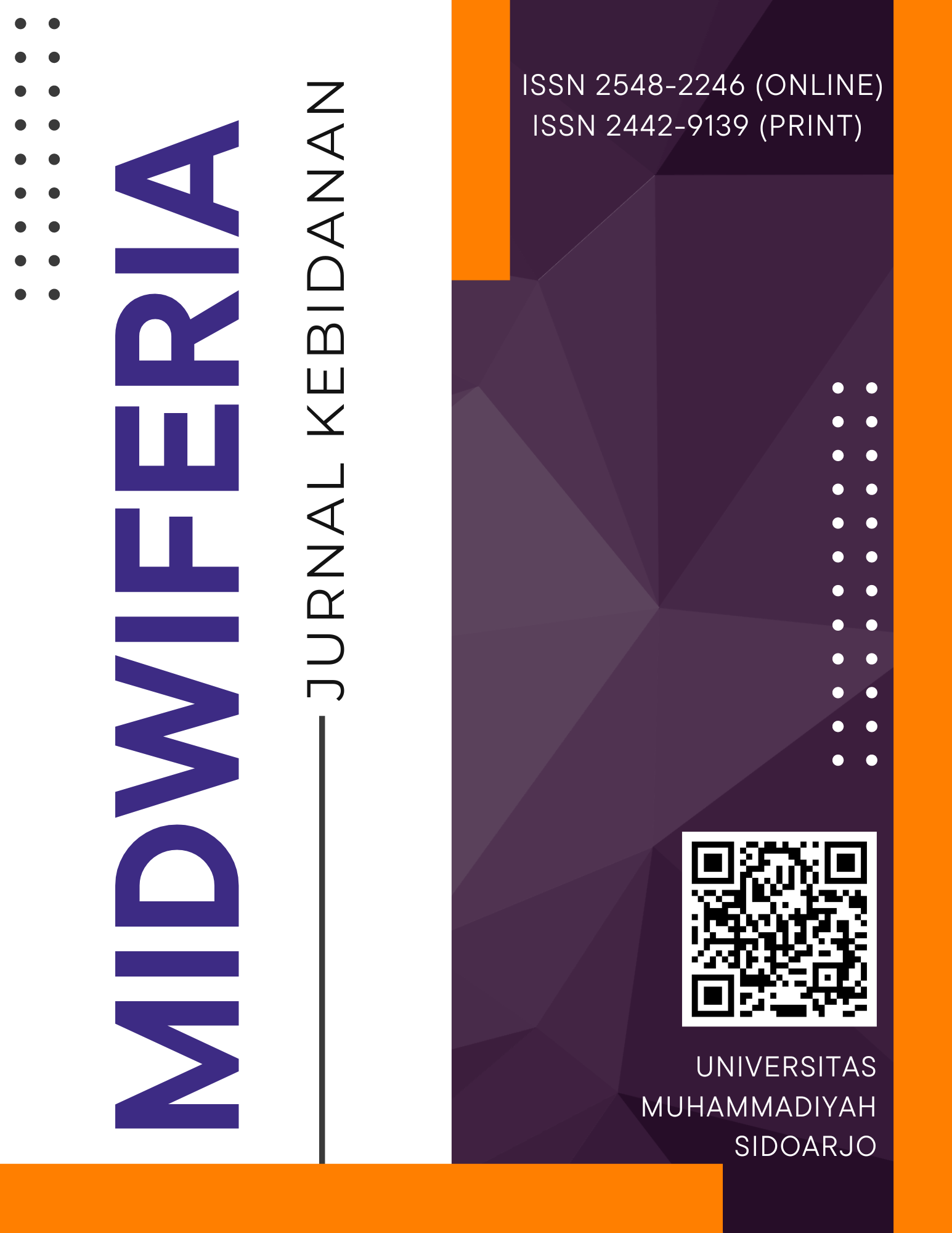Vaginal Birth After Cesarean (VBAC)
DOI:
https://doi.org/10.21070/midwiferia.v7i2.1316Keywords:
vaginal birth after cesarean; VBAC characteristic, childbirth.Abstract
Jenis persalinan merupakan salah satu faktor penentu angka mortalitas dan morbiditas ibu dan anak. Secara statistik persalinan SC (sectio caesarean) meningkat sampai 60% disetiap fasilitas layanan kesehatan. Tujuan penelitain ini adalah mengetahui gambaran VBAC di RS KIA sadewa. Peneltian kuantitatif diambil secara restropektif dengan pendekatan deskriptif. Penelitian dilakukan bulan Mei-Juni 2018. Populasi dalam penelitian ini adalah ibu yang melahirkan secara VBAC pada tahun 2016-2017 dengan jumlah 67 responden. Kriteria inklusi penelitian yaituibu yang melahirkan secara spontan dengan riwayat SC pada persalinan sebelumnya dan mempunyai rekam medis. Kriteria eksklusi adalah data rekam medis yang tidak lengkap. Berdasarkan hasil penelitian, usia responden adalah 20-35 tahun (86,6%) dengan tingkat pendidikan sarjana (46,3%), responden tidak bekerja sebesar 58,2%. Paritas resonden pernah hamil 2-3 kali sebanyak 94%, dengan jarak persalinan ≥ 2 tahun sebesar 97%, dan usia kehamilan saat datang yaitu aterm sebanyak 91%, pembukaan serviks <4 cm sebesar 83,6% dan kondisi selaput ketuban negative sebanyak 88,1%. Kesimpulan responden VBAC adalah mayoritas usia 20-35 tahun dengan tingkat pendidikan sarjana dan tidakbekerja. Pada paritas mayoritas pernah hamil 2-3 kali, jarak persalinan ≥ 2 tahun dengan kehamilan aterm. Pada saat datang pembukaan serviks <4 cm dan selaput ketuban negative.
References
Zhao A, Zhang Y, Peng Y, Li J, Yang T, Liu Z, et al. Prevalence of Anemia and Its Risk Factors Among Children 6 – 36 Months Old in Burma. 2012;87(2):306–11. DOI: https://doi.org/10.4269/ajtmh.2012.11-0660
Widjaja IR, Widjaja FF, Santoso LA, Wonggokusuma E. Paediatrica Indonesiana. 2014;54(2):88–93. DOI: https://doi.org/10.14238/pi54.2.2014.05
Gebreegziabiher G, Etana B, Niggusie D. determinant of anemia in children,northern Ethiopia. Hindawi Publ Corp. 2014;10(11):55–63.
Lozoff B. Iron deficiency and child development. 2007;28(4):560–71. DOI: https://doi.org/10.1177/15648265070284S409
Woldie H, Kebede Y, Tariku A. Factors Associated with Anemia among Children Aged 6-23 Months Attending Growth Monitoring at Tsitsika Health Center, Wag-Himra Zone, Northeast Ethiopia. J Nutr Metab. 2015;2015. DOI: https://doi.org/10.1155/2015/928632
Abdullah K, Hospital T. Iron-deficiency anemia in children. 2010.
Modestine M, Sop K, Mananga M. Risk factors of anemia among young children in rural Cameroon. 2015;4(3):925–35.
Iftikhar A, Bari A, Zeeshan F, Jabeen U, Masood Q, Waheed A. Maternal Anemia and its Impact on Nutritional Status of Children Under the Age of Two Years. 2018;5(3):4519–22. DOI: https://doi.org/10.26717/BJSTR.2018.05.001197
Rahmati S, Delpishe A, Azami M, Reza M, Ahmadi H, Sayehmiri K. Maternal Anemia during pregnancy and infant low birth weight: A systematic review and Meta-analysis. J Reprod Biomed. 2017;15(3):125–34. DOI: https://doi.org/10.29252/ijrm.15.3.125
Ouf N, Jan M. The impact of maternal iron deficiency and iron deficiency anemia. Saudi Med Joiurnal. 2015;36(2):146–9. DOI: https://doi.org/10.15537/smj.2015.2.10289
Burman D, Burman D. Haemoglobin Levels in Normal Infants Aged 3 to 24 Months , and the Effect of Iron. 1972;12(October 1971). DOI: https://doi.org/10.1136/adc.47.252.261
Savoie N, Rioux F. Impact of Maternal Anemia on the Infant ’ s Iron Status at 9 Months of Age. Can J Public Heal. 2002;93(3):203–7. DOI: https://doi.org/10.1007/BF03405001
Ntenda PAM, Nkoka O, Bass P, Senghore T. Maternal anemia is a potential risk factor for anemia in children aged 6 – 59 months in Southern Africa : a multilevel analysis. BMC Public Health. 2018;18(650):1–13. DOI: https://doi.org/10.1186/s12889-018-5568-5
Hulley S, Cummings S, Browner W, Grady D, Newman T. Designing Clinical Research Third edition. Philadelpia: Lippincott Williams&Wilkins; 2007.
Gebreegziabiher G, Etana B, Niggusie D. Determinants of Anemia among Children Aged 6 – 59 Months Living in Kilte Awulaelo Woreda , Northern Ethiopia. Hindawi Pusb;ising Coorporation. 2014;2014. DOI: https://doi.org/10.1155/2014/245870
Rocky M, Chowdhury K, Khan MH, Hafiz T. Prevalence and risk factors of childhood anemia in Nepal : A multilevel analysis. PLoS One. 2020;15(10):1–18. DOI: https://doi.org/10.1371/journal.pone.0239409
Who. Haemoglobin concentrations for the diagnosis of anaemia and assessment of severity. Geneva, Switzerland: World Health Organization. 2011. p. 1–6.
WHO. GUIDELINE DAILY IRON. Geneva: WHO; 2016.
Zuffo CRK, Osório MM, Taconeli CA, Schmidt ST, da Silva BHC, Almeida CCB. Prevalência e fatores de risco da anemia em crianças. J Pediatr (Rio J). 2016;92(4):353–60. DOI: https://doi.org/10.1016/j.jpedp.2016.02.008
Engidaye G, Melku M, Yalew A, Getaneh Z, Asrie F, Enawgaw B. Under nutrition, maternal anemia and household food insecurity are risk factors of anemia among preschool aged children in Menz Gera Midir district, Eastern Amhara, Ethiopia: A community based cross-sectional study. BMC Public Health. 2019;19(1):1–11. DOI: https://doi.org/10.1186/s12889-019-7293-0
Li H, Xiao J, Liao M, Huang G, Zheng J, Wang H, et al. Anemia prevalence, severity and associated factors among children aged 6-71 months in rural Hunan Province, China: A community-based cross-sectional study. BMC Public Health. 2020;20(1):1–14. DOI: https://doi.org/10.1186/s12889-020-09129-y
Grantham-McGregor S, Ani C. Iron-deficiency anemia: reexamining the nature and magnitude of the public health problem. J Nutr. 2001;131(2):649S-668S. DOI: https://doi.org/10.1093/jn/131.2.649S
Shukla AK, Srivastava S, Verma G. Effect of maternal anemia on the status of iron stores in infants: A cohort study. J Family Community Med. 2019;26(2):118–22. DOI: https://doi.org/10.4103/jfcm.JFCM_115_18
Susilowati. Gizi dalam Daur Kehidupan. Ndung: PT. Refika Aditama; 2016.
Santos J, Rates S, Lemos S, Lamounier J. Consequences of anemia on language development of children from a public day care center. J Pediatr. 2009;27(1):67–73. DOI: https://doi.org/10.1590/S0103-05822009000100011
Akca SA, Bostanci MO. The impact of anemia and body mass index ( BMI ) on neuromotor development of preschool children. Medicine (Baltimore). 2017;63(9):779–86. DOI: https://doi.org/10.1590/1806-9282.63.09.779






